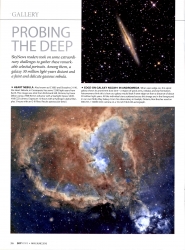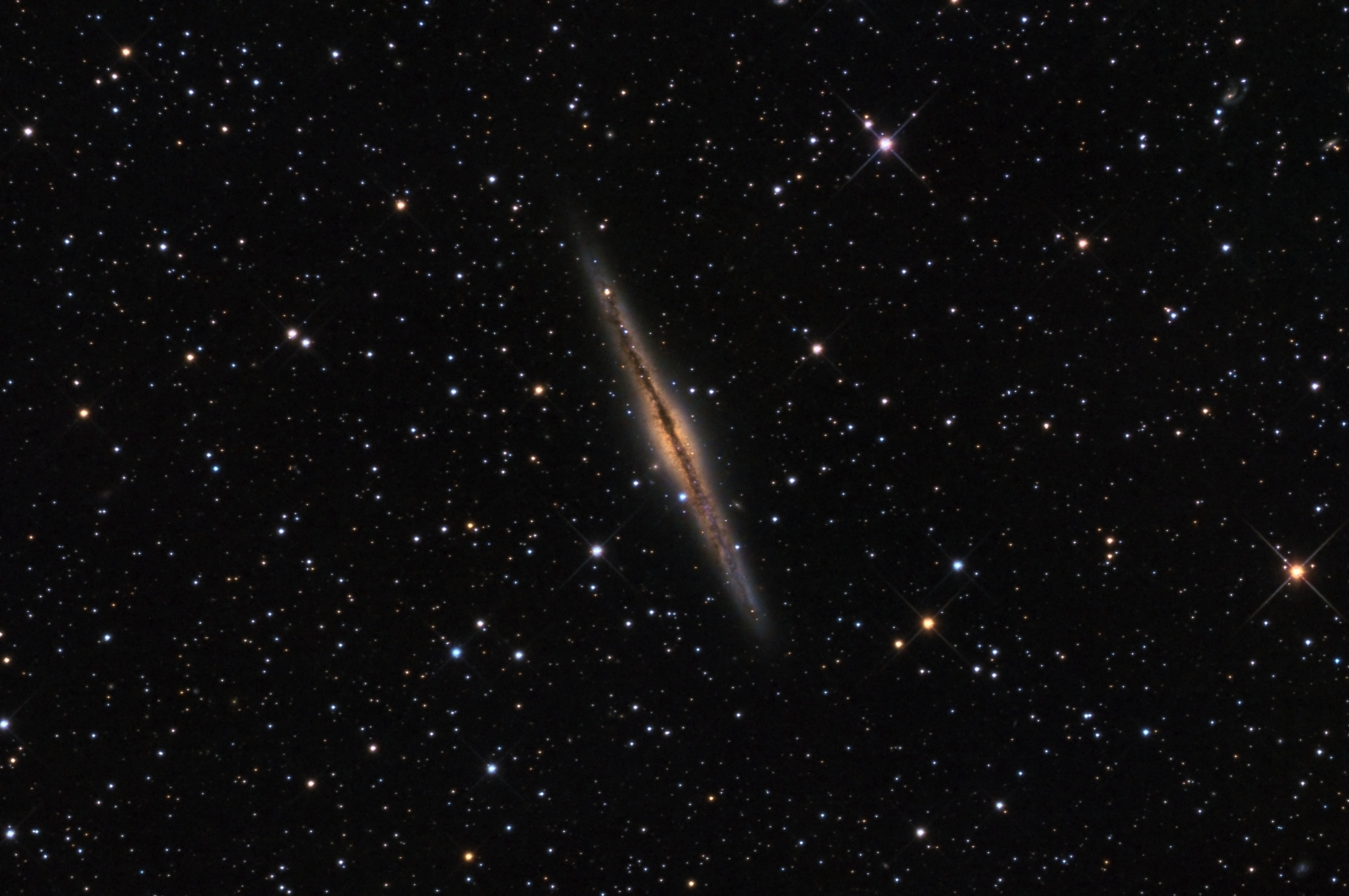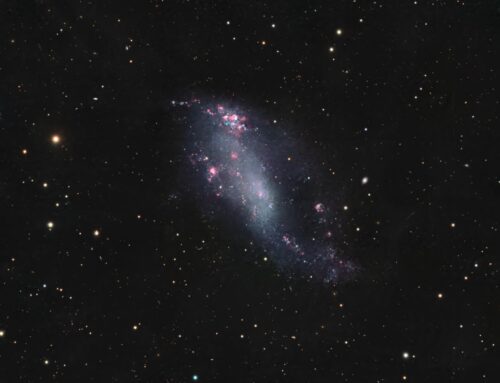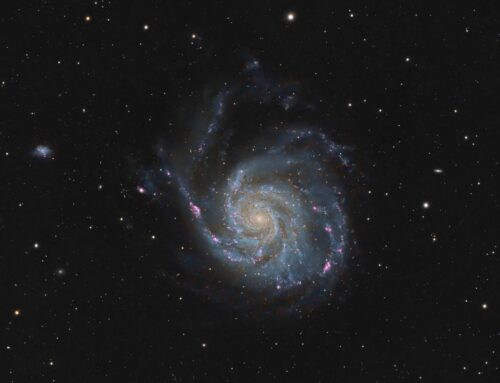NGC891
Click image for full size version
February 4, 2016, May/June 2016 SkyNews magazine, Astronomy Magazine Picture of the Day September 12, 2016

 NGC is an edge-on spiral galaxy located in the constellation Andromeda, about 30 million light years away. It shows a prominent dust line with lots of details, and some astronomers think that it looks similar to how our own galaxy would look seen edge-on from a distance. There are many faint galaxies far in the distance in this image. Look at the upper and lower right corners and to the right of the bulge of NGC891 for three of the most prominent. Remember that when you look at galaxies, all of which are very far away (millions to billions of light years) you are seeing at them as they were long ago. All of the stars you see in this image are in the foreground, within our own Milky Way galaxy.
NGC is an edge-on spiral galaxy located in the constellation Andromeda, about 30 million light years away. It shows a prominent dust line with lots of details, and some astronomers think that it looks similar to how our own galaxy would look seen edge-on from a distance. There are many faint galaxies far in the distance in this image. Look at the upper and lower right corners and to the right of the bulge of NGC891 for three of the most prominent. Remember that when you look at galaxies, all of which are very far away (millions to billions of light years) you are seeing at them as they were long ago. All of the stars you see in this image are in the foreground, within our own Milky Way galaxy.
I posted a previous version of this image in October 2013, and it was published several times (Astronomy Magazine Online Picture of the Day, March 1, 2014; Back Cover, Journal of the Royal Astronomical Society of Canada, August 2014 edition; SkyNews website Dec. 16, 2015). The 2016 version reveals quite a bit more detail and more subtle colouration. The galaxy also appears longer and wider, in the new image, because I did not darken the background too much, which also means there are more stars and galaxies visible.
Tekkies:
SBIG STL-11000M camera, Baader LRGB filters, 10″ f/6.8 ASA astrograph, Paramount MX. Guided with STL-11000’s internal guider. FocusMax for focusing. CCD Commander to automate the sessions. Acquistion, guiding and calibration using Maxim-DL. Registration, drizzle integration and all other processing in PixInsight. Shot from my SkyShed in Guelph, Ontario. No moon. Average to very good transparency and good seeing.
14x10mL, and 6x10m R, G and B unbinned frames (total=5hr20m).
RGB
Creation and cleanup: L, R, G and B masters were prepared with DrizzleIntegration. The R, G and B masters were combined with ChannelCombination, and the resulting RGB image was cropped and processed with DBE, followed by BackgroundNeutralization and ColorCalibration.
Linear Noise Reduction: MultiscaleLinearTransform was used to reduce noise in the background areas of the RGB image. Layer settings for threshold and strength: Layer 1: 3.0, 0.5 Layer 2: 2.0, 0.39 Layer 3: 1.0, 0.25 Layer 4: 0.5, 0.1. A mask was used to protect high signal areas.
Stretching: HistogramTransformation was applied to make a pleasing yet bright RGB image.
Synthetic Luminance
Creation and cleanup: The R,G, B and L masters were combined using ImageIntegration tool (average, additive with scaling, noise evaluation, iterative K-sigma / biweight midvariance, no pixel rejection) to create the SynthL channel. The image was cropped to match the RGB and DBE was applied.
Deconvolution: A copy of SynthL was stretched to use as a deconvolution mask. A star mask was made from unstretched SynthL to use as a local deringing support. Deconvolution was applied (75 iterations, regularized Richardson-Lucy, external PSF made using DynamicPSF tool with about 20 stars; local deringing at 70% and global dark deringing at 0.01).
Linear Noise Reduction: MultiscaleLinearTransform was applied to reduce the noise. Layer settings for threshold and strength: Layer 1: 3.0, 0.6 Layer 2: 2.0, 0.5 Layer 3: 1.0, 0.4 Layer 4: 0.5, 0.15
Stretching: HistogramTransformation was applied to make an image with similar brightness to the RGB image. TGVDenoise was applied and the image was re-stretched to reset the black point.
Combining SynthL with RGB:
The luminance channel of the RGB image was extracted, processed and then added back into the RGB image as follows:
1. Extract luminance from the RGB image.
2. Apply LinearFit using SynthL as the reference.
3. Use ChannelCombination in Lab mode to replace the RGB’s luminance with the fitted luminance from step 2.
4. LRGBCombine was then used to make a SynthLRGB image.
Final Processing
MorphologicalTransformation was applied to reduce star elongation. UnsharpMask was applied to the galaxy and mid-sized stars using a mask. Contrast, brightness and saturation were adjusted in several iterations with the Curves tool, with separate adjustments were made for background and stars using a mask.
Image scale is about 0.55 arcsec per pixel for this camera / telescope combination, because DrizzleIntegration was used to double the pixel density.







Great to see this – another one a bit too far north for me to see…..
Congrats on the cover!
Mark
Appreciating the timе and effort уou put іnto your blog and in depth information you present. It’ѕ good to comе across a blog еvery ߋnce in a while tҺat isn’t the ѕame outdated rehashhed material. Fantastic гead! I’ve bookmarkmed уⲟur site аnd I’m
adding your RSS feeds to mу Google account.